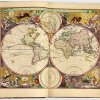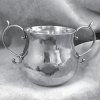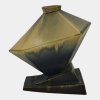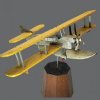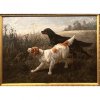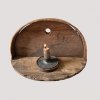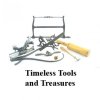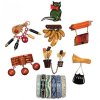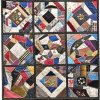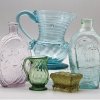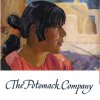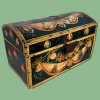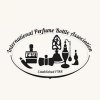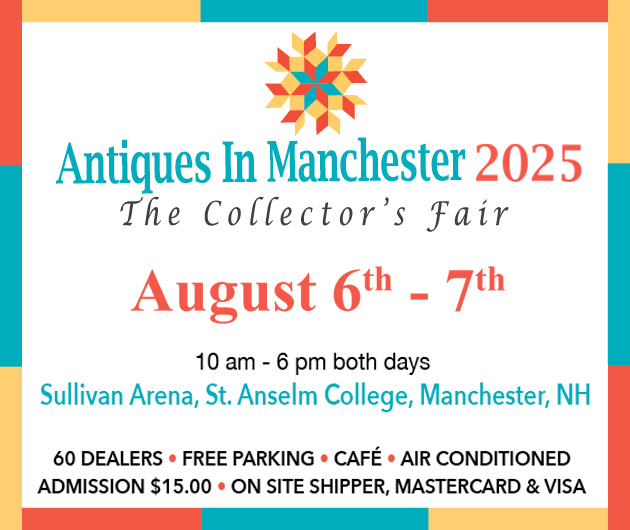The Baltimore Show 2016
August 28th, 2016
Baltimore Art, Antique & Jewelry Show, Baltimore, Maryland
This 36th annual show filled a large part of the Baltimore Convention Center August 25-28. The show was smaller this year; only 320 stands were on the map. There were seven book dealers, down from the more than 30 in recent years and even more a generation ago. One section had stands for a dozen contemporary crafts people who make sculpture, jewelry, clothes, and kokeshi Japanese dolls. This new fine crafts section was publicized, but the exhibitors were not listed by name in the foldout map and dealers’ list, though their booth numbers were on the map. Adding a crafts section was a bone of contention for some antiques dealers who object to combining new things with old, but others said the show is all about good design and quality and having contemporary crafts brings in younger buyers and is good for the trade.
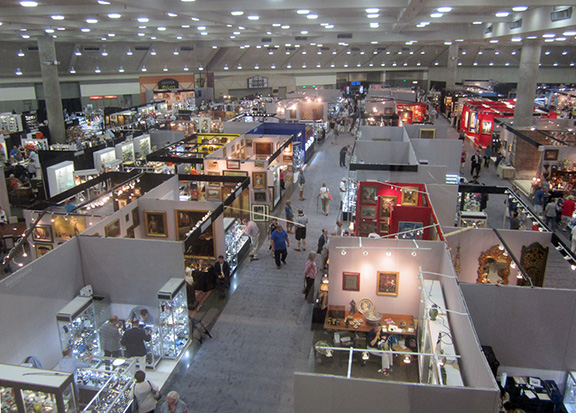
The show seen from above gives some idea of its size.
Dealers liked the smaller show, saying it seemed more manageable and crowded, and bustling aisles are good for business. Diament knows how to get people in the door with lots of national and local advertising, interviews with dealers on local TV shows, and free tickets sent to everyone who had ever bought anything at this show before.
“There is a lot more art and less silver and plenty of jewelry this year,” said Diament just before the show opened. “I predict in the future we will have more 20th-century design and fine craft—that is the trend—while the core of the show, antiques of all periods, countries, and mediums will continue on the stands of dealers who have shown here for years. These dealers have a following, and their clients come from all parts of the U.S. to enjoy Baltimore at the end of summer with its great restaurants, crabs, water taxis from Inner Harbor to Fell’s Point, and comfortable hotels close to the convention center.”
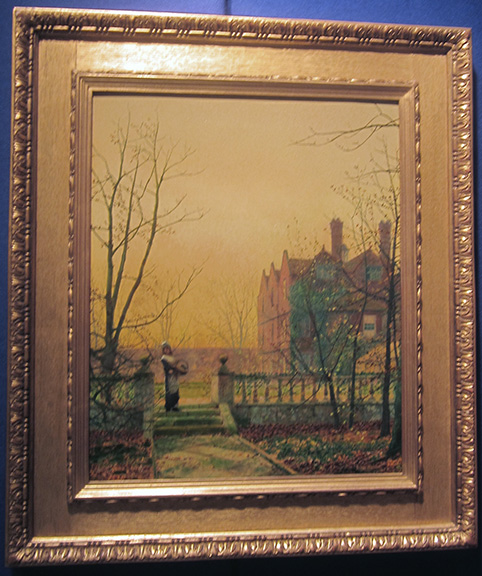
Rehs Galleries, New York City, offered Autumn Gold by John Atkinson Grimshaw (1836-1893), this 18½" x 15" oil on board, signed and dated “1880+,” for $225,000.
Dealers said they see serious collectors from New York, Washington, Virginia, and even from California and Florida at this show that they see nowhere else. The biggest change over the years is the absence of European dealers showing and buying, a reflection of the European economy. A lot of different languages are spoken at the show by people who live in the U.S.; some of them are show dealers, and others are dealers and collectors who come to shop.
This year some of the dealers in majolica were missing because the Majolica International Society held a convention and sale in a hotel next door. They offered visits to museums and private collections and a talk by Ulysses Grant Dietz, chief curator at the Newark Museum. Those who attended the majolica convention came to shop the Baltimore show.
 The rarest piece, and highest quality, was one of the original copies of the Portland Vase made by Josiah Wedgwood between 1791 and 1796. It was on the M.S. Rau Antiques stand. It stopped showgoers in their tracks. Bill Rau brought it from New Orleans, and it screamed perfection, dwarfing all his other treasures. It is one of the 30 or so original Portland Vases that Wedgwood made, and the only one still in private hands. It was priced at $285,000.
The rarest piece, and highest quality, was one of the original copies of the Portland Vase made by Josiah Wedgwood between 1791 and 1796. It was on the M.S. Rau Antiques stand. It stopped showgoers in their tracks. Bill Rau brought it from New Orleans, and it screamed perfection, dwarfing all his other treasures. It is one of the 30 or so original Portland Vases that Wedgwood made, and the only one still in private hands. It was priced at $285,000.
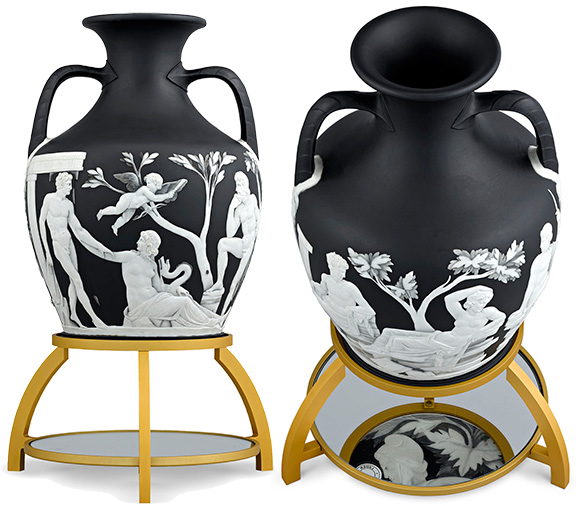
Bill Rau of M.S. Rau Antiques, New Orleans, Louisiana, with his usual large stand up front, offered the last Wedgwood copy of the Portland Vase in private hands for $285,000. It is number 22 of the first edition that Josiah Wedgwood made after the Roman masterpiece of cameo glass, circa A.D. 25, was discovered in the tomb of the Roman Emperor Alexander Severus in the 16th century. It eventually found its way to the collection of Sir William Hamilton in England, and the British sculptor John Flaxman probably brought it to Josiah Wedgwood’s attention and suggested he make a copy in ceramic.
Wedgwood’s copy is considered a “tour-de-force of ceramic art,” testimony to Wedgwood’s superior skill and dedication to perfection. Wedgwood’s oven records list 43 first-edition copies of the Portland Vase produced between 1791 and 1796, 11 of which were broken during the firing process. In all it is believed that around 30 first-edition vases were completed, though an unknown number of these were somewhat damaged; one of these imperfect examples is currently in the Victoria & Albert Museum in London. The perfect examples, like the one Rau offered in Baltimore, are in the British Museum, London; Wedgwood Museum, Stoke-on-Trent; Art Institute of Chicago; Birmingham (Alabama) Museum of Art; Museum of Fine Arts, Boston; Fitzwilliam Museum, Cambridge, U.K.; and the National Gallery of Victoria, Melbourne, Australia, among others.
Many, but not all, of these first editions were numbered inside the rim with a manganese pencil; the highest recorded number is 30. According to Rau, these are without a doubt the best examples made by Wedgwood’s hand, as they are the only ones that match the complexity of the original, particularly in the superior shading of the cameo. The one for sale, number 22, was made for the Dowager Duchess of Beaufort, one of the original subscribers.
The Portland Vase is incorporated into the Wedgwood logo used on its backstamp.
“The first editions are also more substantial in weight compared to later copies. I wish I had brought a 19th-century example, which I have, to Baltimore,” said Rau.
This example was exhibited at the Royal Ontario Museum, Toronto, from 1951 to 1953. From 1953 until 1971 it was owned by Samuel and Catherine Oster in Philadelphia, and it sold at Sotheby’s in London in November 1971 to Paul Lauer of Massachusetts for approximately $50,000. Rau thinks his price, $285,000, is fair for such a rarity, noting that Wedgwood First Day’s Vase, a black encaustic copy of a red-figured vase, 10" tall, one of six thrown (only four survived the firing) by Josiah Wedgwood on the opening day of the Etruria Factory, June 13, 1769, sold at Christie’s London on July 7, 2016, for a record £482,500 ($625,320), more than double its estimate. That vase had been on loan to the Potteries Museum & Art Gallery in Stoke-on-Trent since 1979.
Not everything was that expensive. Jill Fenichell of Brooklyn offered a pair of very large Villeroy & Boch Mettlach cachepots of world’s fair quality, decorated with figures taken from William Morris designs and putti for handles. They were $27,500 the pair. There was a lot of ironstone on a number of stands. Janice Paull of Portugal, who sells Mason’s ironstone and other English ironstone china, 1790-1850, sold a lot it from her small stand on the center red carpet aisle. Baltimore dealers Marcia Moylan and Jacqueline Smelkinson had a large stand on the red carpet aisle jammed with Coalport, New Hall, Derby, Chelsea, and Royal Worcester porcelain, much of it in the Imari palette, for which they have a loyal following. They seemed to sell Victorian and Georgian jewelry first. They said they met new customers and had a good show.
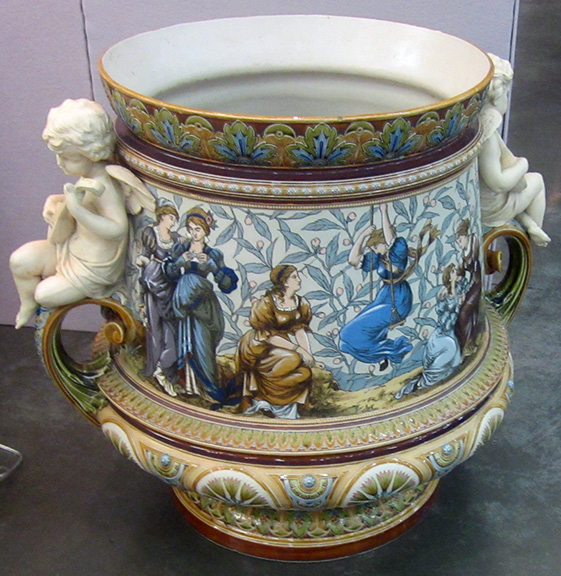
Jill Fenichell offered two Villeroy & Boch Mettlach planters (one shown), 23" high x 33" wide, with painted scenes after William Morris. She priced them at $27,500. She said she had a good show selling silver, spoons, Chamberlain Worcester, bronzes, boxes, Staffordshire, and glass to a diverse audience of all ages.
The jewelers all do business, but it is hard to figure out how much, and it seems as if they are continuously dealing with each other. Kris Charamonde of Lake Worth, Florida, said the hot corner of the jewelry market is colored stones and signed one-of-a-kind pieces by the great French jewelers such as Cartier, Van Cleef & Arpels, Schlumberger, etc. There were just few stands with stunning costume jewelry and five contemporary craftsmen with their own jewelry. Three stands had Chanel and Hermès handbags and one had Hermès scarves. Another offered Louis Vuitton luggage.

Lawrence Thompson of Sundial Farm, Greenlawn, New York, offered this French magician clock, dated 1838, for $62,000.
As usual House of Whitely, Dania Beach, Florida, showed fossil art, mostly fish that are millions of years old, mined in Wyoming. There were specialists in canes, autographs, advertising, napkin rings, French art glass, American glass, and silver. There were more vintage clothes along with clothes made by contemporary craftsmen than ever before at this show. Paintings were a mixed bag, most of them contemporary, and there were some prints by the big names. One dealer reported selling nothing the first two days and seven pictures on Saturday and five on Sunday. Dealers said lower-priced art sold; the expensive pictures need time, and they had hopes for follow-up. Dealers look on this show as advertising, with exposure to a huge gate and a chance to shop during setup and afterward.
There seemed to be fewer Asian works of art than in years past. Santos, London, had its usual stand filled with the finest China trade wares, but TK Asian Antiquities, Williamsburg, Virginia, had a stand half the size of years past. The stands with Chinese Imperial wares manned by Asian dealers were sparsely stocked. Diament said half a dozen mainland Chinese dealers took stands in order to get in early to buy back their heritage from the American dealers, and they brought very little to sell. There were, as usual, a few dealers with top-rate Japanese wares; they have a loyal following.
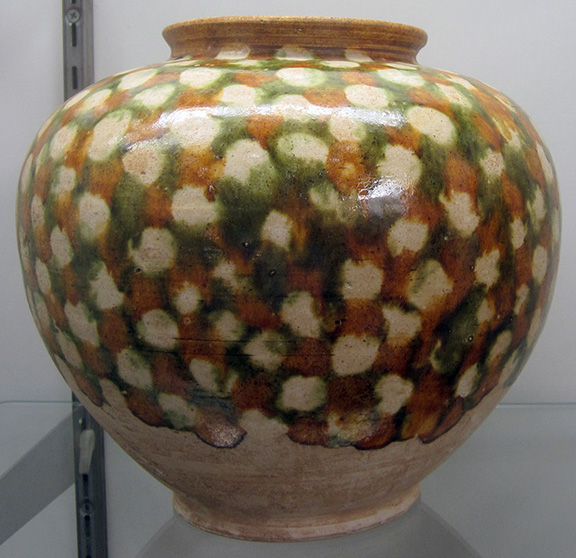
Alexander Acevedo asked $10,000 for this Chinese Tang Dynasty vase. He said he does plenty of business with mainland Chinese buyers and others.
Dealers said more designers came this year than in the past, but there was little American or English furniture for them to buy. There were pieces representing French Gothic Revival, Art Nouveau, Art Deco, and one or two pieces of American Aesthetic Movement, and some 19th-century French furniture and French ormolu clocks.
Ralph and Gretchen Franzese of Pittstown, New Jersey, brought their best 19th-century American glass, redware, painted boxes, a painted chest, and a pair of swan decoys. They said they sold well, finding buyers for folk carvings, American glass, and a pair of large swan decoys, and would consider returning. Zane Moss of Sharon, Connecticut, a dealer who has sold English furniture here for more than 30 years, said except for a tufted couch he sold only small, modestly priced pieces of furniture, some sconces, and china. “Few wanted to spend more than $1500 to $2000 on anything,” he said.
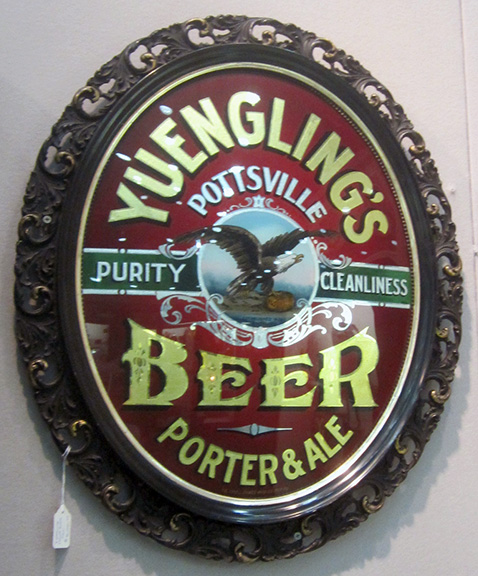
Dan Morphy of Denver, Pennsylvania, asked $40,000 for this rare glass Yuengling’s Beer sign. Yuengling has been producing beer in Pottsville, Pennsylvania, since 1829.
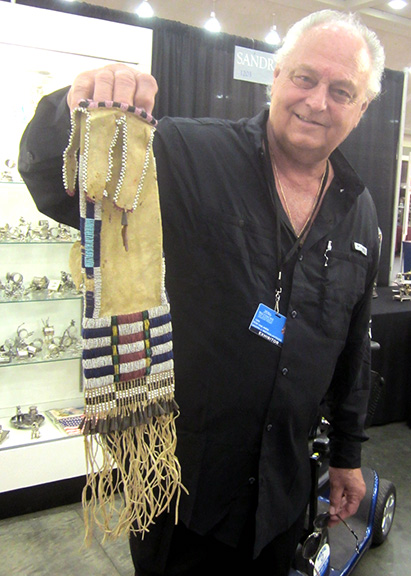
Ronald Van Anda of Lititz, Pennsylvania, offered this Cheyenne pipe bag, circa 1860, for $35,000.
Dealers who sold well said not all customers were in their 70s; some were in their 50s, 40s, and even 30s. “The market may limp along for the next few years, but I can see a new generation of collectors coming along, and they will be buying down the road,” said Jill Fenichell, who said she sold well, offering a broad variety of 18th- and 19th-century estate material fresh to market, which is what the Baltimore show was known for in the old days. “There were a lot of decorators shopping the show,” said Jackie Smelkinson, who sells ceramics. “Now that the housing market is on the upswing, the furniture dealers will come back. Maybe the show was too big in the past,” she said.
Even the smaller show—320 dealers—can’t be seen in only one day. Committed collectors come to Baltimore for a few days and walk through the show every day. Stands with names such as “Anything Will Do,” “Gem de La Gem,” “Hide and Go Keep,” “Lush Life,” “Search Ends Here,” and “Gotta Have It!” make shoppers smile as they compete in the vigorous sport of hunting treasures.
For more information, go to (www.baltimoresummershow.com).
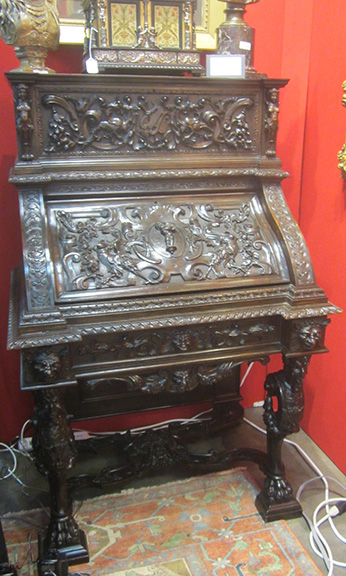
Sayed Hosseini of Antique Legacy, Upland, California, offered this Renaissance Revival Herter Brothers desk and music box. The upper part is the music box that plays 16 songs. It was priced at $45,000.
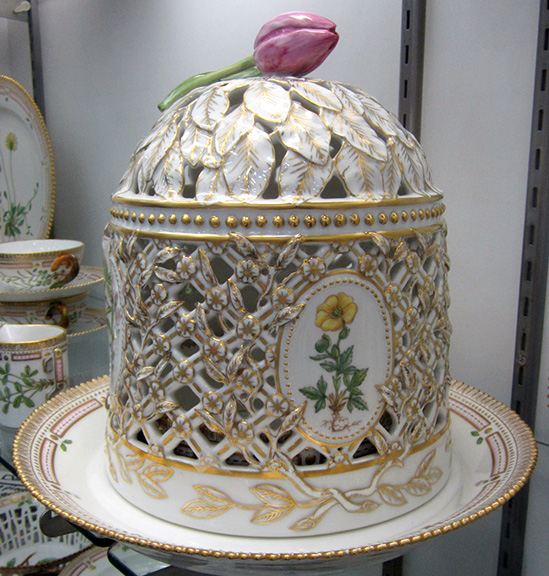
The ice dome is a rare piece of Flora Danica. The Silver Lady asked $17,500 for it. It was used to serve molded ice cream. The dome lifts off, and there is a coaster on the platter to hold the molded dessert.
Originally published in the November 2016 issue of Maine Antique Digest. © 2016 Maine Antique Digest

